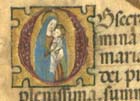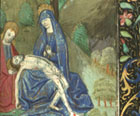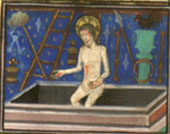Other Prayers
"O" Prayers to the Virgin
Books of Hours often contained additional prayers beside the offices, psalms, and suffrages. Among the most important are two prayers to the Virgin, the "Obsecro te" ("I implore thee") and the "O intemerata" ("O Matchless One"). The Virgin was considered the sinner's ultimate intercessor; as Christ's mother, she was seen as well as the mother of all humanity. The illuminated initial O at the beginning of the "Obsecro te" shows Mary holding the Christ Child. Their warm embrace highlights the close, nurturing relationship between Christ and his mother. The "Obsecro te" asks the Virgin for her aid and counsel as well as for the mercy of her son, Jesus Christ. The user of this Book of Hours would have been comforted and encouraged by this image of the Mother and Child, participating personally in its display of motherly love.Fifteen Joys of the Virgin
"Dulce dame," or "Sweet lady," opens the text known as the Fifteen Joys of the Virgin. Beginning with the Annunciation and culminating with the Virgin's Assumption into heaven, it presents chronologically the joys that Mary experienced as the mother of Christ. The Fifteen Joys are usually illustrated with a depiction of the Virgin and Child. Here it is illustrated with a Pieta showing Mary's lamentation over the body of Jesus after he was removed from the cross. This depiction emphasizes Mary's sorrow over her son's suffering and death, calling to the user's mind the hope of his resurrection, as opposed to the joy of his birth.Supplementary Prayers
Books of Hours could contain a number of additional prayers. Their inclusion may have been a "default" of the shop that produced that the book, or may have reflected the request of the patron. This manuscript contains six short additional prayers illustrated, among other images, by this image of the Man of Sorrows surrounded by the Instruments of the Passion, or Arma Christi. The Man of Sorrows, which depicts Christ rising from his tomb and displaying his wounds, focused the viewer's attention on his sacrifice. The Man of Sorrows was sanctioned by the church as an indulgenced image, and prayer while contemplating the image was believed to secure a petitioner a vast remission of temporal punishment for sins - variously accounted as up to fourteen thousand years reprieve from Purgatory or as many years reprieve as there were wounds upon Christ's body.
Amending the Text
An owner of a Book of Hours sometimes added his or her own prayers on empty or partially blank pages of parchment. These added prayers may signal any of several possible scenarios: purchase or inheritance of a finished book which lacked a prayer favored by the new owner, change in the owner's religious practices, and so on. The prayer seen here was added by hand to a printed book, written in a formal script typical of manuscript Books of Hours. This prayer was written in the form of statement and response, and was devoted to the Virgin Mary.
On this leaf of the Castle Hours 3 an appeal to Christ "the only Son of God", has been added by a later hand in French. This prayer, perhaps composed by an owner who used the book intimately, reflects the author's meditations on Jesus' suffering and the hope of salvation through Christ. The user's decision to physically record this orison suggests the importance of both the prayer and the book. It is possible that the user may have felt that recording the prayer within the Book of Hours would increase the spiritual efficacy of the book as a devotional tool as well as a means of salvation.





